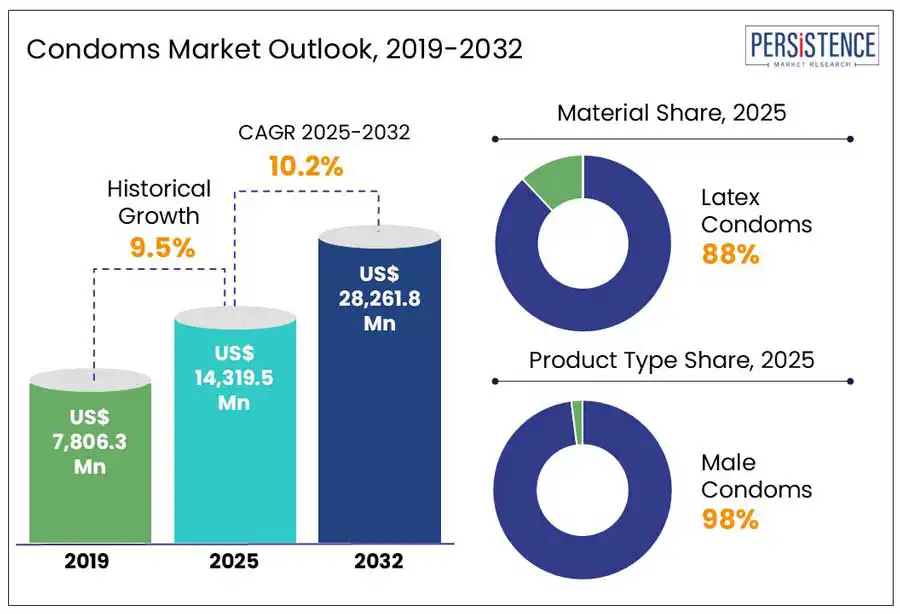ID: PMRREP33247| 199 Pages | 23 May 2025 | Format: PDF, Excel, PPT* | Healthcare

The global Condoms Market size is anticipated to reach a value of US$ 14,319.5 Mn in 2025 and is set to witness a CAGR of 10.2% from 2025 to 2032. The market will likely attain a value of US$ 28,261.8 Mn in 2032. According to the Persistence Market Research report, the condoms industry is experiencing robust growth driven by the increasing awareness of safe sex practices and rising concerns over sexually transmitted infections (STIs) and unplanned pregnancies. Growing acceptance of contraceptives, government initiatives promoting family planning, and expanding access through online and retail channels are boosting demand. Consumers are gravitating towards premium, ultra-thin, and textured variants that enhance user experience. Manufacturers are focusing on product innovation, sustainable materials, and targeted marketing to women and underserved regions. The market is also benefiting from discreet e-commerce availability and the normalization of sexual wellness discussions across diverse cultures.

Key Industry Highlights:
|
Global Market Attribute |
Key Insights |
|
Condoms Market Size (2025E) |
US$ 14,319.5 Mn |
|
Market Value Forecast (2032F) |
US$ 28,261.8 Mn |
|
Projected Growth (CAGR 2025 to 2032) |
10.2% |
|
Historical Market Growth (CAGR 2019 to 2024) |
9.5% |
Rising awareness of sexually transmitted infections (STIs) and HIV prevention is a key driver for the condoms market. The World Health Organization (WHO) emphasizes condom use as an effective method to reduce the transmission of HIV and other STIs. According to the CDC, consistent condom use can reduce HIV transmission risk by up to 85%. In regions such as sub-Saharan Africa, where HIV rates are high, condom access and education are critical components of public health strategies. The UN's UNAIDS also highlights condoms' importance in achieving the goal of ending the AIDS epidemic by 2030. As awareness grows globally, more individuals are turning to condoms as a reliable preventive measure, driving market growth.
The condom industry is severely hampered by the lack of knowledge and awareness. 48% of high school students in the United States who were sexually active said they had not used a condom during their most recent sexual experience. Even in the absence of pre-exposure prophylaxis (PrEP), a ten-year research from the University of Washington found that younger homosexual and bisexual men were using condoms less frequently. Concerns regarding higher risks of STIs and unwanted pregnancies were raised after the World Health Organization (WHO) reported a decline in the usage of condoms among 15-year-olds in 42 countries between 2014 and 2022. These figures highlight the need for thorough sexual education and awareness campaigns to encourage regular condom usage and reduce related health hazards.
There is a big market opportunity due to the rising demand for eco-friendly condoms. Because they are not recyclable and chemicals-free, traditional latex condoms have an adverse effect on the environment. The majority of the 10 billion latex condoms produced each year, according to the UN Population Fund, wind up in landfills. As a result, companies such as Glyde and Sustain are developing sustainable substitutes. While Glyde sells fair-trade certified goods, sustain condoms are cruelty-free, vegan, and made from latex that is obtained ethically. Customers are looking for eco-friendly options more and more as environmental worries grow. Manufacturers have the chance to innovate and enter a market that values environmental and social responsibility due to the rising demand for sustainable products.
Since latex condoms are widely accessible, reasonably priced, and be effective, they dominate the global market. When worn regularly and appropriately, latex condoms are very efficient at preventing the spread of STIs, including HIV, and lowering the risk of unwanted pregnancies, according to the WHO. Latex condoms are a dependable option for protecting sexual health because, as laboratory studies have shown, they offer an almost impermeable barrier to particles the size of STI germs. Furthermore, latex condoms perform better than other materials, according to the Centers for Disease Control and Prevention (CDC), which also states that they are the best kind of condoms for HIV prevention. Latex condoms continue to dominate the market as a result of these characteristics.
Pharmacies and drugstores remain the leading distribution channels for condoms globally due to their accessibility, privacy, and association with healthcare. In countries like India, the Ministry of Health and Family Welfare has collaborated with pharmacy networks to distribute condoms under family planning programs. Similarly, the CDC in the U.S. supports condom distribution through pharmacies as part of HIV/STI prevention efforts. Consumers often trust pharmacies for discreet, reliable access to contraceptives, particularly in conservative cultures. While e-commerce is growing especially among younger consumers seeking privacy, pharmacies dominate in volume due to physical reach and health system integration. In rural regions and developing countries, public health initiatives frequently rely on drugstores to reach underserved populations. Thus, pharmacies remain critical to both commercial and government-led condom distribution strategies.

Asia Pacific leads the global condom market due to its large population, effective government initiatives, and heightened awareness of sexual health. Programs such as India’s Nirodh initiative and Thailand’s “100% Condom Use Programme” have been instrumental in promoting condom use and reducing HIV infections, particularly among high-risk groups. These efforts have significantly impacted population growth rates and public health outcomes. The region's commitment to sexual health, coupled with increasing consumer demand for contraception, positions Asia Pacific as a dominant force in the condom market. The combination of progressive policies and expanding market needs continues to drive the growth of the condom industry in this region.
North America maintains a significant presence in the global condom market, primarily due to comprehensive public health initiatives, widespread access to sexual health education, and a robust healthcare infrastructure. In the United States, the Centers for Disease Control and Prevention (CDC) supports Condom Availability Programs (CAPs) in schools, which have been shown to increase condom use among sexually active students without promoting earlier sexual initiation. The CDC also reports that 67.4% of adolescent males aged 15–19 used a condom during their last sexual encounter, reflecting ongoing efforts to promote safe sexual practices. Additionally, the National Survey of Family Growth indicates that 8.7% of women aged 15–49 currently use male condoms as a contraceptive method. These initiatives underscore North America's commitment to sexual health, driving the growth of the condom market in the region.
Europe's large population, robust healthcare system, and active public health initiatives make it a crucial region in the worldwide condom market. However, according to WHO data, between 2014 and 2022, the percentage of 15-year-olds using condoms decreased from 70% to 61% for boys and from 63% to 57% for girls. The ECDC reported that gonorrhea, syphilis, and chlamydia rates increased by 48%, 34%, and 16% in 2022, respectively, as a result of this decline. Socioeconomic gaps are also associated with lower condom usage; 33% of teenagers from low-income families’ report not using contraception, compared to 25% of their richer counterparts. These statistics highlight Europe's importance as both a high-demand market and a region needing stronger sexual health interventions and awareness to reverse declining trends and address growing public health risks.
The global condoms market is highly competitive, with global and regional players focusing on innovation, brand differentiation, and strategic partnerships. Key companies compete through product variety, sustainable materials, and expanding distribution channels, especially in emerging markets across Asia Pacific and Latin America.
Key Industry Developments
The global market is estimated to increase from US$ 14,319.5 Mn in 2025 to US$ 28,261.8 Mn in 2032.
The global Condoms Market is driven by rising sexual health awareness, government initiatives, product innovation, and e-commerce drive the global condoms market.
The market is projected to record a CAGR of 10.2% during the forecast period from 2025 to 2032.
Opportunities include rural penetration, female-focused products, digital marketing, premium innovations, and untapped emerging markets.
Major players include FUJI LATEX CO., LTD., Reckitt Benckiser Group PLC, Church & Dwight Co., Inc., Karex Berhad, LELO iAB, Lifestyles and Others.
|
Report Attribute |
Details |
|
Historical Data/Actuals |
2019 - 2024 |
|
Forecast Period |
2025 - 2032 |
|
Market Analysis Units |
Value: US$ Mn, Volume: As applicable |
|
Geographical Coverage |
|
|
Segmental Coverage |
|
|
Competitive Analysis |
|
|
Report Highlights |
|
|
Customization and Pricing |
Available upon request |
By Material
By Product Type
By Distribution Channel
By Region
Delivery Timelines
For more information on this report and its delivery timelines please get in touch with our sales team.
About Author